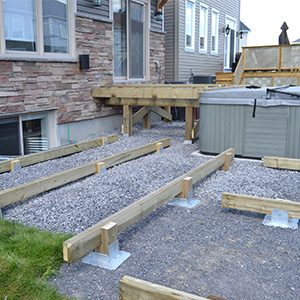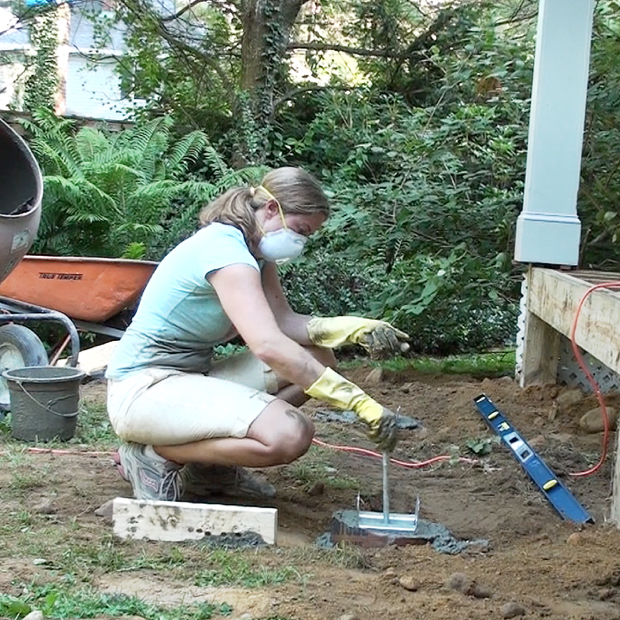Secure Structures, Lasting Impressions: Mastering the Art of Deck Footings Installation
Picking the Right Deck Footings for Security and Durability
When it pertains to developing a deck, one of the most critical decisions you will make is choosing the right grounds for stability and sturdiness. The long life and security of your deck depend greatly on the kind of grounds you select, as they offer the essential assistance and stability to hold up against the test of time. With a myriad of options available, it can be frustrating to determine which grounds are best fit for your certain needs. In this discussion, we will certainly explore the different types of deck footings, consider the vital elements to evaluate when choosing, and look into the benefits and drawbacks of various choices. By the end, you will have a more clear understanding of the selections available and be much better geared up to make an educated decision for your deck project.
Sorts Of Deck Footings
These grounds consist of a round hole loaded with concrete, which gives a solid structure for the deck articles. Concrete pier footings are relatively simple to set up and provide superb security, making them a popular option for many deck tasks.
An additional sort of ground is the helical heap footing. Helical heaps are steel shafts with helical plates connected to them. These grounds are installed by screwing them into the ground, which develops a protected structure for the deck. Helical heap grounds are suitable for areas with challenging soil problems, as they can be mounted in practically any kind of type of soil. If required., they also allow for simple change and leveling of the deck.
Additionally, some builders choose precast concrete grounds. These grounds are made of durable concrete and can be found in different sizes and shapes to suit various deck designs. Precast concrete grounds are practical to mount and offer a secure base for the deck framework.
Lastly, one more option is the post-in-anchor ground system. This type of footing entails driving a metal anchor into the ground and attaching it to the deck blog post. It provides versatility in regards to positioning the deck articles and appropriates for decks with light-weight structures.
When picking the right kind of deck footing, it is vital to take into consideration elements such as dirt problems, deck lots, and local building regulations (Deck Footings). Consulting with a specialist service provider or structural engineer can help make sure the ideal ground is picked for a risk-free and secure deck
Factors to Take Into Consideration When Selecting Grounds
When choosing the appropriate grounds for a deck, it is crucial to carefully take into consideration different factors such as dirt conditions, deck load, and adherence to local building regulations. These elements play a substantial function in guaranteeing the security and longevity of the deck structure.
The kind of soil on which the deck will be built figures out the type of footings needed. On the other hand, decks developed on clay or expansive soils might call for grounds that can fit the soil's tendency to expand and agreement.
One more vital variable is the deck load. The weight of the deck, consisting of the materials used and any prospective live tons such as furnishings or events, need to be considered when choosing footings. The footings should be made to bear the weight of the deck and distribute it evenly to avoid any structural issues or failures.
Finally, adherence to regional building ordinance is critical. Structure codes vary from region to region, and it is vital to abide with the particular requirements established by the neighborhood authorities. Deck Footings. These codes ensure that the deck is constructed securely and satisfies the needed criteria for structural honesty and load-bearing ability
Concrete Footings: Benefits And Drawbacks

Concrete grounds provide numerous benefits and disadvantages when made use of as the foundation for a deck. On the favorable side, concrete grounds offer exceptional stability and toughness. Concrete is a rigid and strong product that can support hefty loads and withstand various climate condition. It likewise has a lengthy life expectancy, making it a trustworthy option for long-lasting use.
An additional advantage of concrete footings is their flexibility. They can be put into different sizes and shapes to fit numerous deck layouts and setups. Concrete footings can be personalized to fit the specific demands and requirements of the deck framework.
Nevertheless, there are additionally some disadvantages to making use of concrete grounds. This can enhance the overall expense of the deck project and might need specialist assistance.

Helical Piers Vs. Sonotubes: Which Is Much better?
In considering the foundation alternatives for a deck, the contrast in between helical piers and sonotubes is vital in figuring out the useful reference premium option. They are twisted into the ground using hydraulic equipment, offering a secure and durable structure for the deck.
When it pertains to security and toughness, helical piers have the upper hand. The helical plates on the piers create a solid hold with the dirt, stopping any type of movement or shifting of the deck. This is especially valuable in locations with unpredictable or changing soil problems. Sonotubes, on the various other hand, depend solely on the concrete filling for stability, which might not offer the exact same level of toughness and resistance.
In regards to setup, helical piers are reasonably easier and faster to install compared to sonotubes. The hydraulic machinery utilized to turn the piers right into the ground guarantees a efficient and you can find out more quick procedure. Sonotubes, on the other hand, need excavating openings and putting concrete, which can be taxing and labor-intensive.
In addition, helical piers are a more versatile alternative. If needed, they can be made use of in different soil conditions and can be changed or strengthened. Sonotubes, on the other hand, may require extra support, such as rebar, in certain soil problems or locations with high load requirements.
Picking the Right Footings for Your Deck's Measurements
For optimum structural integrity, it is vital to very carefully select the suitable grounds that align with the dimensions of your deck. The measurements of your deck, including its length, size, and elevation, play a substantial role in identifying the type and size of grounds needed.
When picking footings for your deck, it is essential to think about the load-bearing capability of the dirt. The weight of the deck, integrated with the weight of any kind of furnishings or people on it, exerts a considerable force on the grounds (Deck Footings). It is vital to choose grounds that can adequately support this weight without sinking or shifting over time.
Bigger decks with better dimensions need bigger footings to provide sufficient security and support. The form of the footings, whether they are square or round, depends on the style and design of the deck.
Final Thought
To conclude, selecting the ideal deck footings is vital for ensuring stability and sturdiness. Elements such as the type of footings, the deck's measurements, and the benefits and drawbacks of various choices need to be considered. Concrete grounds provide toughness and longevity, yet may be a lot more lengthy and pricey to mount. Helical piers discover this info here and sonotubes have their own advantages and negative aspects. Inevitably, picking the proper grounds for your deck's particular demands is vital for a resilient and successful structure.
These grounds are composed of a cylindrical hole filled up with concrete, which gives a strong structure for the deck blog posts. Concrete pier footings are relatively very easy to install and supply outstanding stability, making them a prominent choice for numerous deck tasks.
Precast concrete grounds are practical to install and supply a stable base for the deck structure.
It uses flexibility in terms of placing the deck articles and is ideal for decks with light-weight frameworks.
Concrete grounds supply several benefits and disadvantages when utilized as the foundation for a deck.